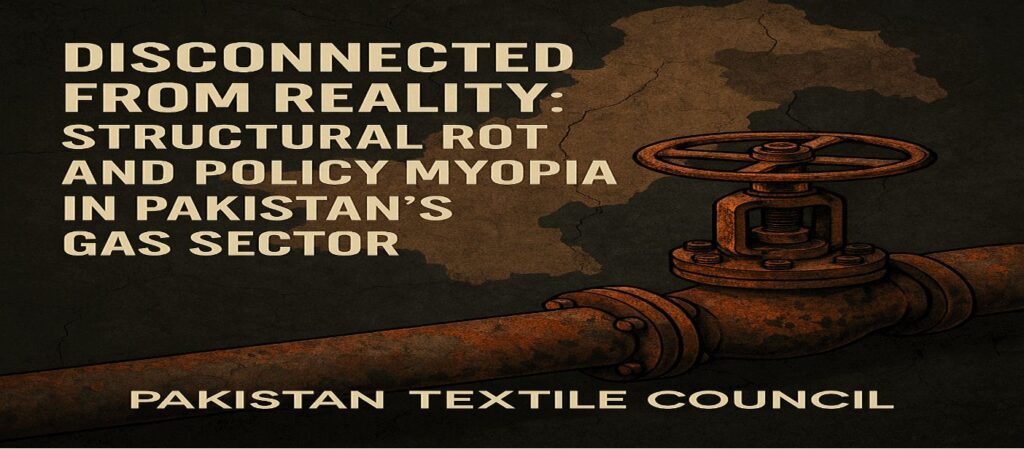Annual Meeting of Pakistan Textile Council – 30th August 2025 – Karachi
DISCONNECTED FROM REALITY: STRUCTURAL ROT AND POLICY MYOPIA IN PAKISTAN’S GAS SECTOR
admin
May 7, 2025
Blog

Writer: MR. ASIM RIAZ AN ESTABLISHED ENERGY EXPERT, M.PHIL. STRATEGIC STUDIES NDU,MASTERS IN ENERGY MANAGEMENT CIIT, B.SC. (MECHANICAL) UET, BS. MATH-PHYSICS PU.
Pakistan’s gas sector is burdened by deeply rooted structural distortions, including monopolistic control by state-owned utilities, rigid long-term contracts, opaque cross-subsidies, and fragmented policy-making across ministries. The absence of a liberalized, competitive gas market has stalled private investment, stifled innovation, and fostered persistent inefficiencies in allocation and pricing.
These systemic flaws have resulted in a market disconnected from fundamentals—one where the most efficient consumers are penalized, and the least efficient remain protected through unsustainable subsidies. In such an environment, commercial discipline has eroded, and resource optimization remains elusive.
A particularly damaging recent intervention is the IMF-driven Captive Gas Levy—proposed as a fiscal reform but ultimately a case of missing the forest for the trees. While intended to bolster short-term revenues, the policy undermines the very foundation of gas sector sustainability by targeting Pakistan’s most efficient and highest-paying consumers: captive power users, many of whom operate Combined Heat and Power (CHP) systems with thermal efficiencies exceeding 80%.
Instead of pursuing structural efficiency, the government imposed a punitive price hike—raising the cost of $4 indigenous gas to over $15.38/MMBtu. It led to an estimated 225 MMCFD collapse in industrial gas demand and a resulting RLNG surplus of 450 MMCFD (3.375 MTPA) —equivalent to 54 unutilized cargoes annually—with diversion costs exceeding $2 billion.
The downstream effects include stranded infrastructure, rising UFG losses, and a worsening circular debt crisis, as high-cost RLNG is rerouted to low-paying, leakage-prone sectors. Rather than correcting inefficiencies, the policy compounds them—highlighting a growing disconnect between fiscal policy objectives and long-term economic rationality. Positioned as part of IMF-endorsed fiscal reforms, the Captive Gas Levy reflects a short-term attempt to shield the national grid from a utility death spiral—driven by the defection of high-paying consumers following the import of over 17 GW of solar PV in calendar year 2024, resulting in 22.8 TWh of demand destruction.
Rather than tackling chronic issues such as poor recovery, AT&C losses, and surplus capacity locked in take-or-pay contracts, the policy penalizes efficient captive gas users to artificially sustain grid revenues. It has also forcibly triggered coal-to-gas switching, as under-dispatched coal IPPs—excluded from the merit order due to transmission constraints—are being substituted with RLNG diverted from industry.
This is not a reflection of energy efficiency, but a policy distortion aimed at preserving IPP capacity payments, while compromising gas sector solvency and industrial competitiveness. Pakistan’s power sector has already accumulated PKR 12,403 billion in financial losses, including PKR 2,393 billion in circular debt, PKR 6,809 billion in direct budgetary support, and PKR 3,201 billion in interest costs.
Grid infrastructure remains unreliable in industrial zones, with unplanned outages, voltage fluctuations, and inadequate transmission capacity. The current pricing framework not only displaces high-efficiency captive systems but also forces RLNG into low-recovery segments, increasing linepack pressure, heightening operational risks, and pushing gas circular debt up by PKR 500 billion in just seven months of FY2025.
Meanwhile, domestic gas production is being shut in to accommodate unutilized LNG, while liquidity constraints choke upstream exploration and development. The policy appears to be treating symptoms while worsening the underlying disease—and risks pushing the gas and power sectors beyond the point of no return.
Recent Posts
News
Blog
Have Any Question?
- +92 51 2726971
- info@ptc.org.pk
